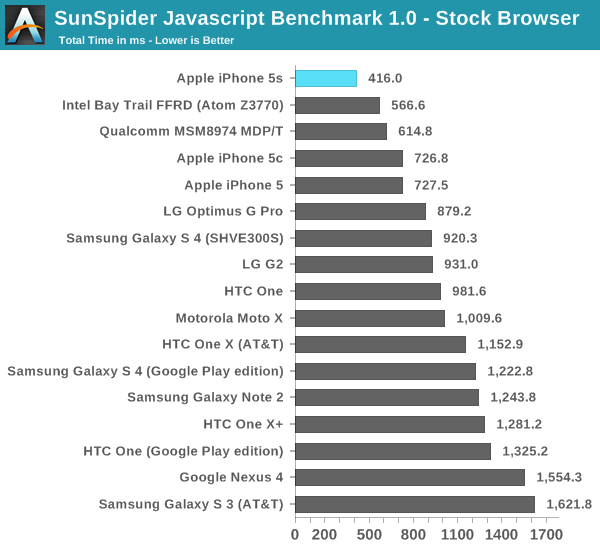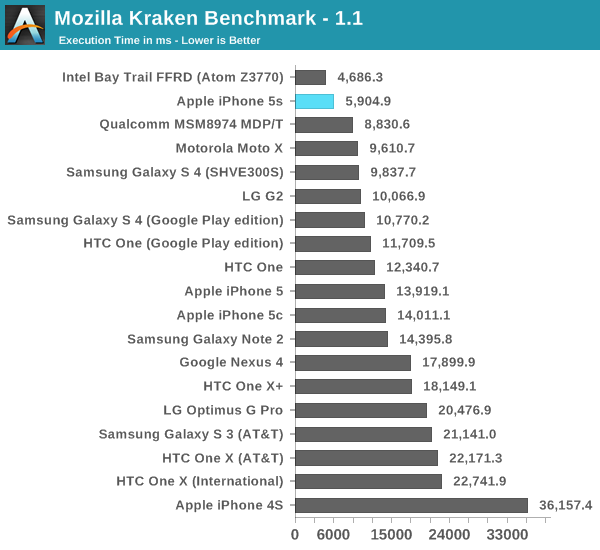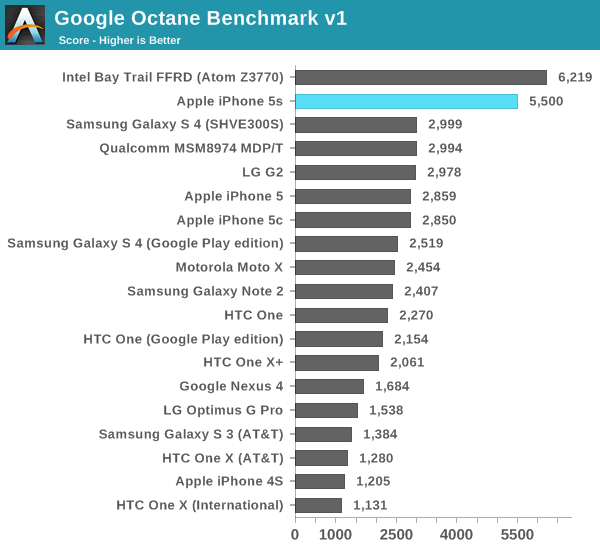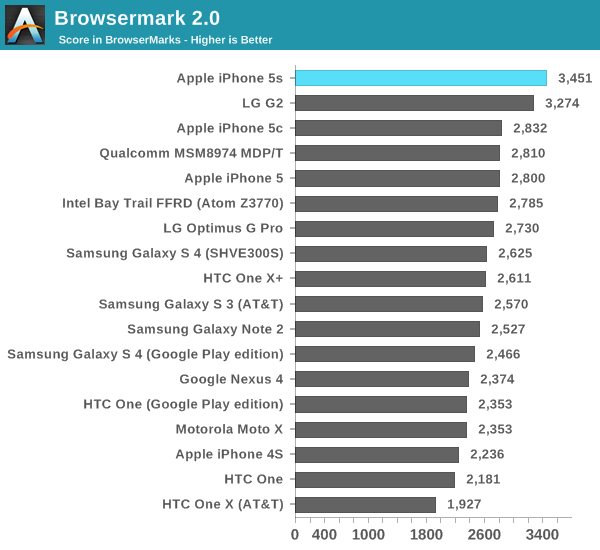The iPhone 5s Review
by Anand Lal Shimpi on September 17, 2013 9:01 PM EST- Posted in
- Smartphones
- Apple
- Mobile
- iPhone
- iPhone 5S
CPU Performance
For our cross-platform CPU performance tests we turn to the usual collection of Javascript and HTML5 based browser tests. Most of our comparison targets here are smartphones with two exceptions: Intel's Bay Trail FFRD and Qualcomm's MSM8974 Snapdragon 800 MDP/T. Both of those platforms are test tablets, leveraging higher TDP silicon in a tablet form factor. The gap between the TDP of Apple's A7 and those two SoCs isn't huge, but there is a gap. I only include those platforms as a reference point. As you're about to see, the work that Apple has put into the A7 makes the iPhone 5s performance competitive with both. In many cases the A7 delivers better performance than one or both of them. A truly competitive A7 here also gives an early indication of the baseline to expect from the next-generation iPad.
We start with SunSpider's latest iteration, measuring the performance of the browser's js engine as well as the underlying hardware. It's possible to get good performance gains by exploiting advantages in both hardware and software here. As of late SunSpider has turned into a bit of a serious optimization target for all browser and hardware vendors, but it can be a good measure of an improving memory subsystem assuming the software doesn't get in the way of the hardware.

Bay Trail's performance crown lasted all of a week, and even less than that if you count when we actually ran this benchmark. The dual-core A7 is now the fastest SoC we've tested under SunSpider, even outpacing Qualcomm's Snapdragon 800 and ARM's Cortex A15. Apple doesn't quite hit the 2x increase in CPU performance here, but it's very close at a 75% perf increase compared to the iPhone 5. Update: Intel responded with a Bay Trail run under IE11, which comes in at 329.6 ms.
Next up is Kraken, a heavier js benchmark designed to stress more forward looking algorithms. Once again we run the risk of the benchmark becoming an optimization target, but in the case of Kraken I haven't seen too much attention paid to it. I hope it continues to fly under the radar as I've liked it as a benchmark thus far.

The A7 falls second only to Intel's Atom Z3770. Although I haven't yet published these results, the 5s performs very similarly to an Atom Z3740 - a more modestly clocked Bay Trail SKU from Intel. Given the relatively low CPU frequency I'm not at all surprised that the A7 can't compete with the fastest Bay Trail but instead is better matched for a middle of the road SKU. Either way, A7's performance here is downright amazing. Once again there's a performance advantage over Snapdragon 800 and Cortex A15, both running at much higher peak frequencies (and likely higher power levels too, although that's speculation until we can tear down an S800 platform and a 5s to compare).
Compared to the iPhone 5, the 5s shows up at over 2.3x the speed of last year's flagship.
Next up is Google's Octane benchmark, yet another js test but this time really used as a design target for Google's own V8 js engine. Devices that can run Chrome tend to do the best here, potentially putting the 5s at a disadvantage.

Bay Trail takes the lead here once again, but again I expect the Z3740 to be a closer match for the A7 in the 5s at least (it remains to be seen how high the iPad 5 version of Cyclone will be clocked). The performance advantage over the iPhone 5 is a staggering 92%, and obviously there are big gains over all of the competing ARM based CPU architectures. Apple is benefitting slightly from Mobile Safari being a 64-bit binary, however I don't know if it's actually getting any benefit other than access to increased register space.
Our final browser test is arguably the most interesting. Rather than focusing on js code snippets, Browsermark 2.0 attempts to be a more holistic browser benchmark. The result is much less peaky performance and a better view at the sort of moderate gains you'd see in actual usage.

There's a fair amount of clustering around 2500 with very little differentiation between a lot of the devices. The unique standouts are the Snapdragon 800 based G2 from LG, and of course the iPhone 5s. Here we see the most modest example of the A7's performance superiority at roughly 25% better than the iPhone 5. Not to understate the performance of the iPhone 5s, but depending on workload you'll see a wide range of performance improvements.










464 Comments
View All Comments
akdj - Friday, September 27, 2013 - link
I completely agree---that said, we're really only 5 years 'in'. The original iPhone in '07, a true Android follow up in late '07/early '08---those were crap. Not really necessary to 'bench' them. We all kinda knew the performance we could expect, same for the next generation or two. In the past three years---Moore's law has swung in to high gear, these are now---literally---replacement computers (along with tablets) for the majority of the population. They're not using their home desktop anymore for email, Facebook, surfing and recipes. Even gaming---unless their @ 'work' and in front of their 'work Dell' from 2006, they're on their smartphones...for literally everything! In these past three years---and it seems Anand, Brian and crew are quite 'up front' about the lack of mobile testing applications and software----we're in it's infancy. 36 real months in with software, hardware and OS'es worth 'testing, benchmarking, and measuring' their performance. Just my opinion....and I suppose we're saying the same thing.That said---even Google's new Octane test was and is being used lately---GeekBench has revised their software, it's coming is my point. But just looking at those differences in the generations of iPhones makes it blatantly obvious how far we've come in 4/5 short years. In 2008 and 9---these were still phones with easier ways to text and access the internet, some cool apps and ways to take, manipulate and share pics and videos. Today----they do literally everything an actual computer does and I'd bet---in a lot of cases, these phones are as or more powerful, faster and more acessible than those ancient beige boxes from the mid 2000s a lot of folks have in their home office;)
Duck <(' ) - Thursday, October 3, 2013 - link
they are posting false benchmark scores. Same phones score different in youtube vids.iPhone 5 browsermark 2 score is around 2300
check here https://www.youtube.com/watch?v=iATFnXociC4
sgs4 scores 2745 here https://www.youtube.com/watch?v=PdNE4NoFq8U
ddriver - Wednesday, September 18, 2013 - link
Actually, there are quite a lot of discrepancies in this review.For starters, the "CPU performance" page only contains JS benchmarks and not a single native application. And iOS and Android use entirely different JS engines, so this is literally a case of comparing apples to oranges.
Native benchmarks don't compare the new apple chip to "old 32 bit v7 chips" - it only compares the new apple chip to the old ones, and also compares the new chip in 32bit and 64 bit mode. Oddly enough, the geekbench at engadget shows tegra 4 actually being faster.
Then, there is the inclusion of hardware implementation in charts that are supposed to show the benefits of 64bit execution mode, but in reality the encryption workloads are handled in a fundamentally different way in the two modes, in software in 32bit mode and implemented in hardware in 64bit mode. This turns the integer performance chart from a mixed bad into one falsely advertising performance gains attributed to 64bit execution and not to the hardware implementations as it should. The FP chart also shows no miracles, wider SIMD units result in almost 2x the score in few tests, nothing much in the rest.
All in all, I'd say this is a very cleverly compiled review, cunningly deceitful to show the new apple chip in a much better light than it is in reality. No surprises, considering this is AT, it would be more unexpected to see an unbiased review.
I guess we will have to wait a bit more until mass availability for unbiased reviews, considering all those "featured" reviews usually come with careful guidelines by the manufacturer that need to be followed to create an unrealistically good presentation of the product. That is the price you have to pay to get the new goodies first - play by the rules of a greedy and exploitative industry. Corporate "honesty" :)
I don't say the new chip is bad, I just say it is deliberately presented unrealistically good. Krait has expanded the SIMD units to 128 bit as well, so we should see similar performance even without the move to a 64bit ecosystem. Last but not least, 64bit code bloats the memory footprint of applications because of pointers being twice as big, and while those limited memory footprint synthetic benches play well with the single gigabyte of ram on this device, I expect an actual performance demanding real world application will be bottlenecked by the ram capacity. All in all, the decision to go for 64 bit architecture is mostly a PR stunt, surely, 64bit is the future, but in the case of this product, and considering its limited ram capacity, it doesn't really make all that sense, but is something that will no doubt keep up the spirit of apple fanboys, and make up for their declining sales while they bring out the iphone 6, which will close all those deliberately left gaping holes in the 5s.
Slaanesh - Wednesday, September 18, 2013 - link
Interesting comment. I'd like to know what Anand has to say about this.ddriver - Wednesday, September 18, 2013 - link
I am betting my comment will most likely vanish mysteriously. I'd be happy to see my concerns addressed though, but I admit I am putting Anand in a very inconvenient position.Mondozai - Wednesday, September 18, 2013 - link
It's all a conspiracy. In fact your comment has already disappeared, but in its place is now a hologram effect that makes it impossible to tell it from the blank space. So why put in the hologram and not just delete it? Because Anand is playing mind games with us.And who said I typed this comment? It could have been someone else, someone doing Anand's bidding.
I admit I am putting his scheme of deception in a very difficult position right now.
/s
ddriver - Wednesday, September 18, 2013 - link
Few days ago I posted a comment criticizing AT moderators being idle and tolerant of the "I make $$$ sitting in front of my mac" spam, few minutes later my comment was removed while the spam remained, which led me to expect similar fate for this comment. Good thing I was wrong ;)WardenOfBats - Wednesday, September 18, 2013 - link
I'd honestly like to see your misleading comment removed as well. You seem to think that anyone cares what the 32bit performance is of the 5S when everyone knows damn well that app developers are going to be clamouring to switch to the 64bit tech (that Android doesn't even have or support) to get these power increases. Other than that, the rest of your comment is just nonsense. The whole point is that the iPhone 5S is faster and the fact that they use different JS engines is a part of that. Apple just knows how to make software optimizations and hardware that runs them faster and you can see how they just blow the competition away.CyberAngel - Thursday, September 19, 2013 - link
Misleading? Yes! In favor of Apple!You need to double the memory lines, too and caches and...oh boy!
The next Apple CPU will be "corrected" and THEN we'll see...hopefully RAM is 8GB...
Ryan Smith - Thursday, September 19, 2013 - link
As we often have to remind people, we don't delete comments unless they're spam. However when we do so, any child comments become orphaned and lose their place in the hierarchy, becoming posts at the end of the thread. Your comment isn't going anywhere, nor have any of your previous comments.